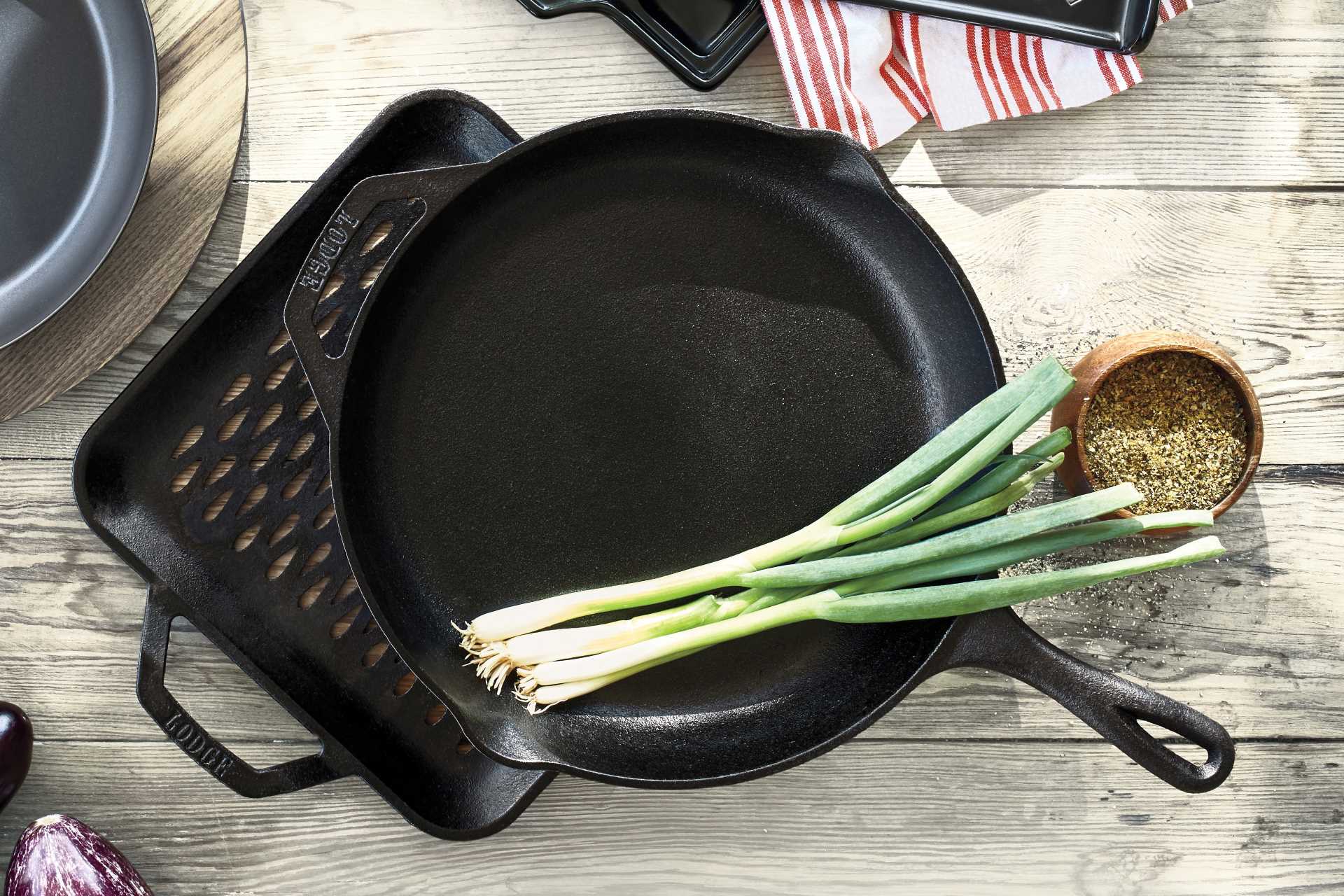Cast iron skillets are an essential piece of cookware for any home chef.
They’re durable, nontoxic and great for searing, sautéing and frying—and you can cook almost anything in them, from scrambled eggs to steak. They can even be used to bake cakes and breads!
Plus, they’re relatively inexpensive and can last for decades with proper care. However, if you’ve just bought a cast iron skillet, you’ll need to properly season and clean it before you can use it. Seasoning your skillet will create a nonstick surface and cleaning it properly will help it maintain it.
Use this guide to learn best practices and helpful tips on how to care for, clean and season your cast iron skillet so you can enjoy it for years to come.
Hungry for more? Refine your cast iron cooking skills and learn hands-on tips from our resident chefs in one of our cooking classes!
Explore Our Cooking Classes
Benefits of Cast Iron Skillets
Cast iron skillets are well-loved for a reason. They’re a versatile, durable and affordable cooking tool—and many people even inherit them from family members over the years. Some of the top benefits of cast iron cookware include:
- Durability. Cast iron skillets are incredibly durable and can last a lifetime with proper care, and they can even be passed on from generation to generation. If anything happens to the finish on your pan, it’s easy to make the pan like new again with a good scrub and reseasoning.
- Even heating. Cast iron skillets retain heat well and distribute it evenly, allowing for precise cooking. This makes them ideal for searing and browning foods.
- Versatility. Cast iron skillets can be used on most cooktops (including induction!) as well as in the oven, under the broiler and even on the grill or an open flame.
- Nonstick. With proper seasoning, cast iron skillets can become naturally nonstick, eliminating the need for cooking sprays. Cast iron skillets also don’t contain any of the harmful chemicals or coatings sometimes found in nonstick materials, which can be released if the surface becomes scratched or damaged over time.
- Easy to clean. With hot water and a brush—or some coarse sea salt—cast iron skillets can be easily cleaned without the need for harsh chemicals.
Types of Cast Iron Cookware
While many people think of traditional skillets when they think of cast iron, there are many different types of cookware options that are made out of this durable material.
There are two types of cast iron cookware: raw cast iron and enameled cast iron.
Raw cast iron, which is the more traditional type of cast iron cookware, needs to be seasoned before its first use.
Enameled cast iron, on the other hand, is a type of cast iron cookware that has been coated with a layer of porcelain. This layer makes this type of cookware easier to clean and maintain, and it doesn’t need to be seasoned before using. Enameled cast iron is also more resistant to rust and corrosion and won’t react to acidic foods (which can happen with improperly seasoned raw cast iron cookware). Enameled cast iron cookware is not entirely nonstick, however, so experienced cooks use regular cast iron and enameled cast iron pans for different applications.
Griddles, and even woks can be made out of cast iron. Popular brands of both enameled and raw cast iron cookware include Lodge, Le Creuset and Staub.
How To Season Your Cast Iron Skillet
Seasoning cast iron cookware helps to create a nonstick surface on the cookware and protects it from rust and corrosion. Additionally, seasoning helps to create a patina on the pan which aids in cooking, as it helps to distribute heat more evenly across the cookware. Note, you do not need to do this for enameled cast iron as the enamel creates a nonstick surface.
Today, cast iron cookware often comes preseasoned and ready to cook with—so if you’re buying new, be sure to check the packaging for details. However, you’ll still need to season your pan—preseasoned or not—as part of regular maintenance to keep it looking new and to help ensure it stays nonstick.
Seasoning (or reseasoning) your pan is easy, and only requires a few simple steps.
Steps to season your cast iron skillet
- Preheat the oven to 400°F.
- If your pan is dirty, clean the pan with hot water, a brush and coarse salt if needed. Jump to the “How to Clean Cast Iron Cookware ” section for more information on how to safely clean your cast iron skillet.
- Dry the pan thoroughly with a clean cloth or paper towel.
- Apply a thin layer of oil to the entire surface of the pan. An oil with a high smoke point, such as grapeseed, vegetable or canola oil, is the best option.
- Place the pan upside down on a foil-lined baking sheet and bake in the preheated oven for one hour.
- Allow the pan to cool completely before using.
- Wipe off any excess oil before using the pan.
How To Clean Cast Iron Cookware
Cleaning cast iron can be a little tedious, but the effort is well worth it to ensure the seasoned surface remains intact and nonstick. The trick to cleaning cast iron is to remove food residue without damaging the nonstick surface you’ve worked hard to create!
To clean your cast iron skillet or pan, all you really need is hot water and a brush—but there are few extra steps you can take if your skillet is particularly soiled or has a strong flavor you’d like to neutralize.
Steps to Clean Cast Iron Cookware
- Scrub the surface of the cookware with hot water and a stiff brush.
- For heavily soiled cast iron skillets or pans, take a few tablespoons of coarse salt (kosher salt or sea salt) and sprinkle it on the cooking surface. Use a clean paper towel and scrub the salt into the pan to remove food bits and debris. Note: You can also use a small amount of soap to help remove excess debris—this won’t completely ruin your finish, but you may need to reseason your pan. Jump to the “Tips to Care for Your Cast Iron Skillet” section below.
- Rinse the cookware with hot water, then dry it completely with a towel. To ensure the cookware is completely dry—and to prevent possible rust spots—you can also place the cookware back in the oven or on the stovetop for a few minutes to help evaporate any extra water.
- Rub the cookware with a light layer of vegetable or canola oil, then take a paper towel and remove any excess so no oil residue remains.
Chef’s Tip: If you have a rusted cast iron skillet, don’t worry! Rusted cast iron skillets can be cleaned and revitalized with a little elbow grease and steel wool. For rusted cast iron skillets or pans, simply use the lowest grade steel wool to gently scrub off any rust spots. After, wash the pan with warm, soapy water before reseasoning.
Cleaning Enameled Cast Iron
If you’re cleaning enameled cast iron cookware, you’ll want to clean your pan differently than the guidance above.
To clean enameled cast iron, be sure to let your pan come to room temperature before cleaning, as cold water on a hot surface could cause the enamel to crack due to thermal shock. Once the pan has cooled completely, wash with a soft, natural or nylon sponge or brush and a mild dish soap. Avoid metal sponges, abrasive cleaners or anything that could scratch the enameled surface.
Tips To Care for Your Cast Iron Skillet
Caring for your cast iron skillet requires a little extra effort, but with proper care, your skillet will last for years.
- Refresh your cast iron skillet regularly. Simply heat the pan on the stovetop for ten minutes on medium-low heat. While the pan is hot, use a paper towel to carefully coat the inside with a thin layer of oil. Turn the heat off and let the pan cool, then use or store for later use. If a total reseasoning is needed, follow the “Steps to season your cast iron skillet” above.
- Always preheat your skillet before cooking. To do this, place the skillet over medium-high heat for several minutes before adding oil or butter.
- Clean the skillet while still warm. Use a nonabrasive scrubber and hot water to remove cooked-on food.
- Don’t ever put the skillet in the dishwasher. Detergent can strip the seasoning from the skillet and the heat from the dishwasher can damage the skillet.
- Dry the skillet thoroughly. After cleaning, dry the skillet with a clean cloth or paper towel and then place it on the stove or in the oven to dry completely.
- Store the skillet in a dry place. Cast iron skillets are prone to rust, so store the skillet in a dry place to prevent moisture from settling on the surface.
- Avoid cooking acidic foods in cast iron, as the chemical reaction causes rust (unless the cast iron is enameled). If you do cook acidic foods in your cast iron, just be sure to reseason your cookware after cooking to keep it in top condition.
- Don’t leave food in cast iron for long periods of time, as it can acquire a metallic flavor. (This is not harmful, as iron is a vital nutrient.)
- Don’t use metal cooking utensils. Metal utensils can scratch the surface of the skillet and damage the seasoning.
- Reseason occasionally. If your skillet is looking dull and dry, it’s time to reseason it. Follow the “Steps to season your cast iron skillet” above for more details.
Hungry for more? Refine your cast iron cooking skills and learn hands-on tips from our resident chefs in one of our cooking classes!
Explore Our Cooking Classes


JOIN THE CONVERSATION